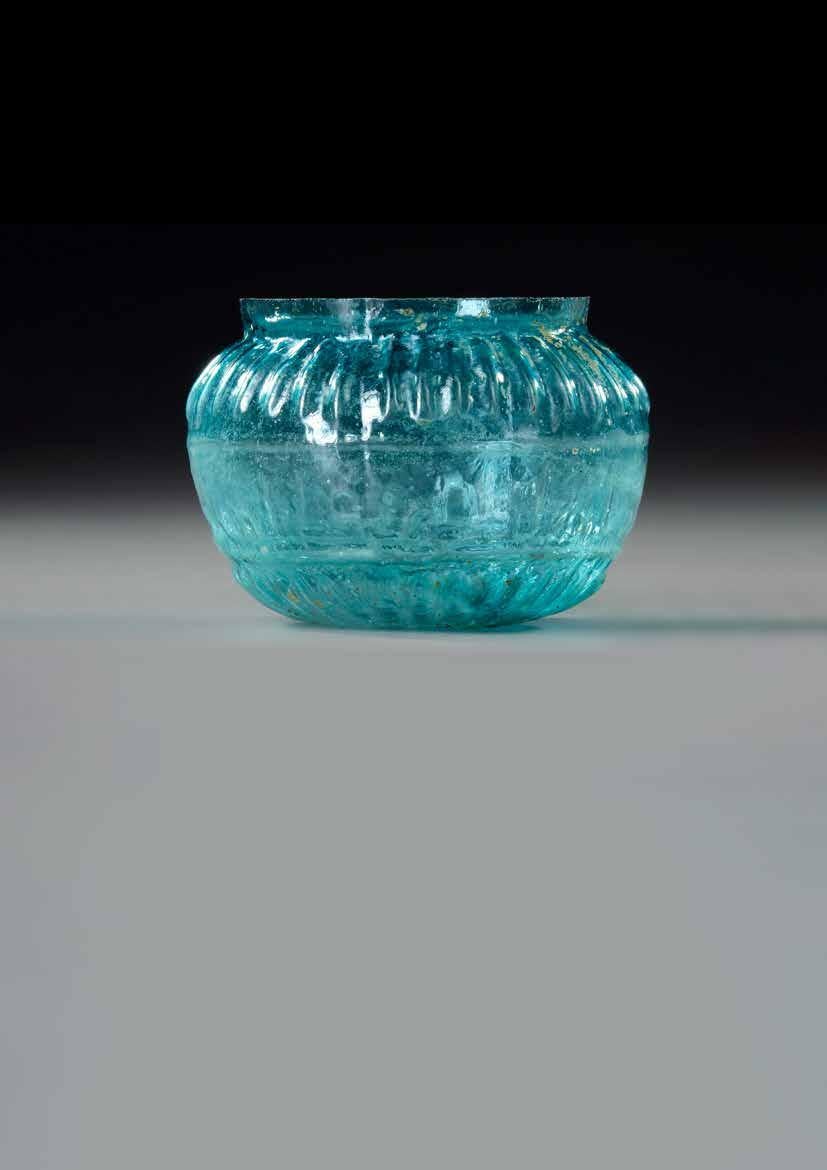
5 minute read
A RASULID GOLD AND SILVER-INLAID BRASS CANDLESTICK, 13TH CENTURY

The base of truncated conical form encircled by two pointed ridges, the projecting shoulder leading to a concave driptray, the cylindrical neck surmounted by a broad socket tapering to the mouth, decorated with bands of Arabic calligraphy in elegant thuluth script around the body, the shoulder and the neck, small roundels containing birds, vestiges of gold and silver-inlay.
Advertisement
Inscriptions
Around the mouth: bi rasm al-Jinan al-alami al-mawlawi al-amir al-kabir algazi al-mujahidi al-murabiti ( made for High Authority, the Lordly, the Great Emir, the Conqueror, the Learned, the holy warrior, the Diligent, the Possessor”.
Around the shoulder: al-maqarr al-kabir al-murabiti al-ali al-mawlawi al-maliki al-amir al-alami al-mujahid al-muaid
(“High Authority, the Lordly, the Great Emir, the Conqueror, the Learned, the Diligent, the Possessor, [the officer of] al-Malik al-Nasir”)
Around the body: al-maqarr al-Karim al-’ali al-mawlawi al-maliki al-amiri al-kabiri al-ghazi al-mujahidi al-murabiti al-muthagiri al-muaid (“High Authority, the Lordly, the Great Emir, the Conqueror, the Learned, the Diligent, the Possessor, [the officer of] al-Malik al-Nasir”)
Height: 38 cm.
PROVENANCE
Private collection, France
Estimate € 50.000 - € 80.000
A KASHAN LUSTRE POTTERY JUG, PERSIA, 13TH CENTURY
A pottery jug standing on a splayed unglazed foot-ring and base, globular body with tall and wide cylindrical neck with handle and small thumb-piece on top, painted in brownish lustre. Chain and scroll motifs on the lower part of the body, on the upper part ten lobed medallions reserved in white and decorated with leaf and scroll patterns painted in lustre, chain and scroll motives on the neck and cursive inscription (unread) in white round the rim. Inside the rim Kufic characters of kalimaat al-Tawhid in lustre.
Inscriptions around the rim: Repetition of Persian verses (mostly undeciphered).
Height: 18.5 cm.
CATALOGUE NOTE
Lustre – a metallic glaze – was first used on pottery during the ninth century A.D. in Iraq, but gained more popularity from the tenth century onwards. The town of Kashan became the centre of the Persian lustre industry, and produced some of the most beautiful examples. It was in the thirteenth century that fritware, similar to the ancient Egyptian faience, was developed; composed of quartz and clay, it produced ceramics with a pleasing sheen.
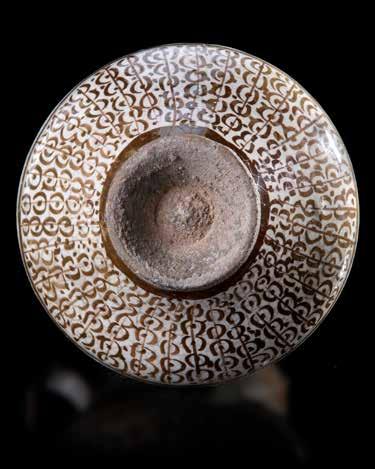
PROVENANCE
Private collection, Switzerland
Estimate € 120.000 - € 150.000
Lot 80
AN ILLUMINATED MINIATURE OCTAGONAL QURAN WRITTEN BY MUHAMMED AL-KHALAWI, TURKEY DATED 1213 AH/1798 AD

A complete Quran, Arabic manuscript on paper, 217ff. with 3 fly-leaves, 19 lines to the page written in minute naskhi script in black ink with a black and gilt border, one illuminated double-page frontispiece in colors and gold containing two miniature of Al-Masjid al-Haram and Al-Masjid Al-Nabawi , a second double-page with striking blu nd gilt decoration framing 7 lines, surah headings in red, some waterstaining mostly restricted to outer margins, dark brown binding with covers painted with floral sprays in gold, leather outer case.
Manuscript: 5.5 by 5.5 cm.
Case: 7.8 by 7.8 cm.
Estimate € 3000 - € 5000
Lot 81
AN OTTOMAN MAJMA’ AL-ANSAB, A GENEALOGY OF THE PROPHET TURKEY, CIRCA 1715
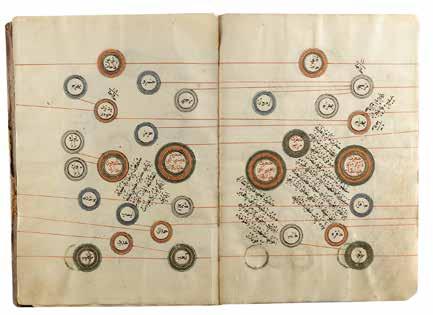
Manuscript on paper, 59 leaves, with names written in black and red naskh script within blue, orange and green circles linked by red lines, comments in black naskh, in brown morocco binding, with flap, tooled medallion. This manuscript of genealogical tables starts with Adam, and traces the Prophet Muhammad and his descendants, the rulers of Persia, the Ottoman sultans (ending with Ahmed III, r.1703-30), and the Qadirite Sufis. The final date given is 1127 AH/1715 AD, although the later roundel giving the name of Sultan Mahmud I and the date 1135 AH/1722 AD, may have been added by a later owner. Folio: 24.5 by 17cm.
Provenance
Christie’s, London, 28 April 1998, lot 68
Estimate € 2000 - € 3000
Lot 82
A MONUMENTAL LATE TIMURID ENGRAVED COPPER BOWL CENTRAL ASIA LATE 15TH-EARLY 16TH CENTURY

Of typical form, the rounded body engraved with elegant floral sprays on hatched ground within hanging medallions with palmettes finials, interspersed with rising medallions with loose quatrefoils and floral sprays, a register of elongated calligraphic cartouches in thuluth script with religious prayer. With the name of its owner, Muhammad Nur al-Din bin Karim.
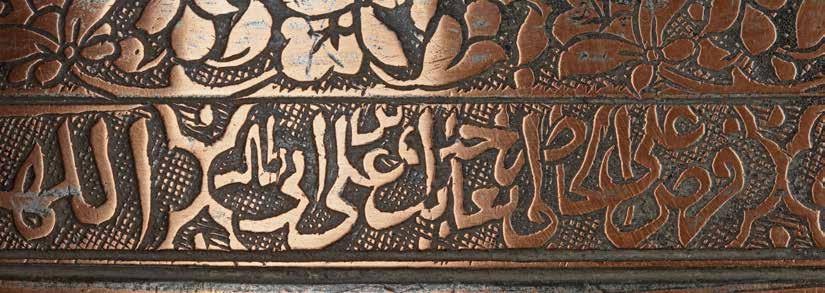
Diameter: 47.5 cm.
Height: 24 cm.
Estimate € 6000 - € 8000
Lot 83
A BOWL DECORATED WITH THREE BIRDS IN FLIGHT, SULTANABAD, 13TH-14TH

CENTURY
Estimate € 8000 - € 12.000
The bowl, worked on a potter’s wheel, is truncated cone-shaped and ends with a small vertical rim and a flat lip.

The decoration is dominated by the grey, black and cream tones of the background; on the outside, the polychromy is enriched by the presence of a wide frieze of cobalt blue dots alternating with diagonal lines and black dots. On the inside, the large tondo features a classic motif for ceramics in this style: three virtually identical birds flying in a landscape covered with flowers and leaves. Drawn in a slightly stylised way, they give the impression of moving quickly, with their wings spread and tails extended in the wind. The vase belongs to the group known as “Sultanabad”, of which the large semi-circular bowl is one of the classic forms (Sultanabad is the name of a town in Iran where a large number of vases of this type have been found; now called Arak, it is located between Isphahan and Hamadan). Sultanabad ceramics were fashionable between the end of the 13th and 14th centuries, during Mongol rule in Iran (reign of the Ilkhanids), but the actual centre of production of these vessels remains a subject of open scientific debate (the workshops of Kashan, etc.) The painted motifs on these vessels are sometimes innovative compared with the styles of contemporary Islamic ceramics. This diversity is explained by the influence of the Mongol dynasty, which is said to have recovered some subjects from the Chinese tradition, such as the phoenix or the lotus flower. Typical of ceramics from the Mongol period is also the technique used for decoration, executed using the so-called colourless underglaze process. The motifs are painted in black, blue or grey on a white slip and then covered with a layer of transparent glaze before firing.
Complete and in excellent condition, but reglued, with a few fillings, small chips and cracks in the glaze. Beige-grey paste with cream slip. Grey, black, grey and blue paint.
Diameter: 29.5 cm.
Provenance
Private collection, Switzerland. Formerly Japanese collection, collected in the 1980-90s.
Bibliography
J., Islamic ceramics, Paris, 1985, pp. 198ff, p. 216, nos. 239-241. WATSON O. Ceramics from Islamic Lands, Kuwait National Museum, The al-Sabah Collection, London, 2004, pp. 373 ff, Q.11-Q14. A bowl preserved in the Louvre
Lot 84
AN OTTOMAN GILT BRONZE CANDLESTICK, LATE 15TH CENTURY
An Ottoman gilt bronze candlestick of bell form with two raised bands, the drip tray surrounded by an openwork foliate arcade, emerging from a tulip shaped mouth a shaft with two raised bands.
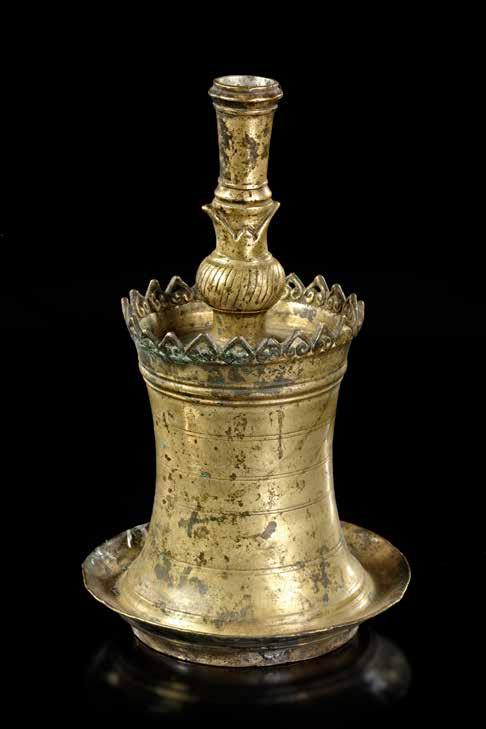
Height: 29 cm.
Diameter: 17 cm.
Estimate € 15.000 - € 20.000
Lot 85
A LARGE OTTOMAN GENEALOGICAL SCROLL (SILSILENAME)

TURKEY, 18TH CENTURY
Arabic and Ottoman manuscript on paper, written in naskh, thuluth and nastaliq script in red and black ink, with the names within gold roundels outlined in black , illuminated headpiece with blue, red and royal gold decoration enclosing Al-Basmallah in black naskh script.
21 m by 27 cm.
Genealogical manuscripts (silsilename) in the form of a scroll or a book were popular in the Ottoman period. Although generally classed as genealogies they in fact do not function strictly as such. Silsilename were very popular in Ottoman Turkey, listing rulers and religious leaders and their line of descent. This particular example is a silsilename of the Prophets commences with Adam through Noah, Abraham, Solomon etc.., tracing the lineage through the Prophet of Islam, the well-know figures of Quraysh tribe, the lineage of the prophet and his wives, the four Rashidun caliphs and their children like Hasan and Hussain.
Estimate € 4000 - € 6000
Lot 86




